The Distribution of Individual Political Attitudes
Stuart A. Rice
In the preceding chapter, at least one type of element that must be reckoned with in considering the content of political attitude was subjected to a certain experimental analysis. Even as a study of stereotypes alone, this analysis was fragmentary and incomplete. Moreover it took no account of other factors which have a part in determining this content. Without further formal consideration of the latter, however, we will pass on to the question of distribution of attitudes.
( 72)
Variability is an outstanding characteristic of social data. Whether we are measuring such physical characteristics as height, weight or chest expansion, or whether we are concerned with intellectual capacities or performances, a sufficiently large number of measurements upon homogeneous individuals seems to point invariably to a continuous distribution from the lowest measures to the highest, with a massing of cases at some point on the scale which is usually about mid-way between the two extremes.
It is assumed that if the number of individual cases could become infinite, every position on the scale, however small the gradations, would be represented by frequencies. In practice, frequencies are assembled together during classification around mid-points, so that a distribution which is theoretically continuous is actually presented in any given series as if it were discontinuous or discrete. The measurements given approximate the actual dimensions. This process of classification, it should be noted, is an artificial one in the sense that the number of classes, together with the location of mid-points or class limits, depend entirely upon the will of the classifier, who is presumably guided by the purposes for which the data are to be employed.[2]
The normal frequency distribution of the individual cases represented by the familiar "bell-shaped curve," results from the operation of a variety of unrelated or slightly related factors which determine the dimensions of the individual case. The effect is to render the combination of factors operating with respect to any individual a matter of chance. In determining a man's height, for example, an indefinite number of hereditary and environmental influences are at work. In the case of a single individual, most of these may make for tallness. They reinforce each other and an excep-
( 73) -tionally tall individual is produced. In the case of another a large majority of the factors may make for shortness. But it is much more likely that while some factors may make for tallness others are making for shortness. These cancel out each other's influence. Hence it is nature's custom within any variety of individuals to give the larger number a medium height.
It appears to be traditional among writers on such subjects as this to assume that readers are familiar with the arts of flipping coins and throwing dice. I shall here follow in the beaten track in offering an illustration. In flipping two coins at a time let us assume that the head of each stands for a factor making for tallness, while the tails represent shortness. In every four throws there is one chance that both will come heads (tallness), one chance of both coming tails (shortness) and two chances of one being heads and the other tails (i.e., of tall and short influences cancelling, leaving medium height). But this will be true only if each coin is equally likely to fall either way. That is, there must be no connection between the way in which the two coins fall, nor must either be more likely to fall one way rather than the other. If the two coins are soldered together at the edge with the same face up, we could get two heads or two tails but never one of each. Or, if the head side of each coin were made of lead and the tail side of aluminum, both coins would come heads together more frequently than they would come tails, or even than they would come one head and one tail. In this case we would call the distribution modal but skewed. If the coins were soldered it would be bi-modal. The three types of distribution referred to would in tabular form be somewhat as follows assuming that two coins were thrown together eight times:
( 74)
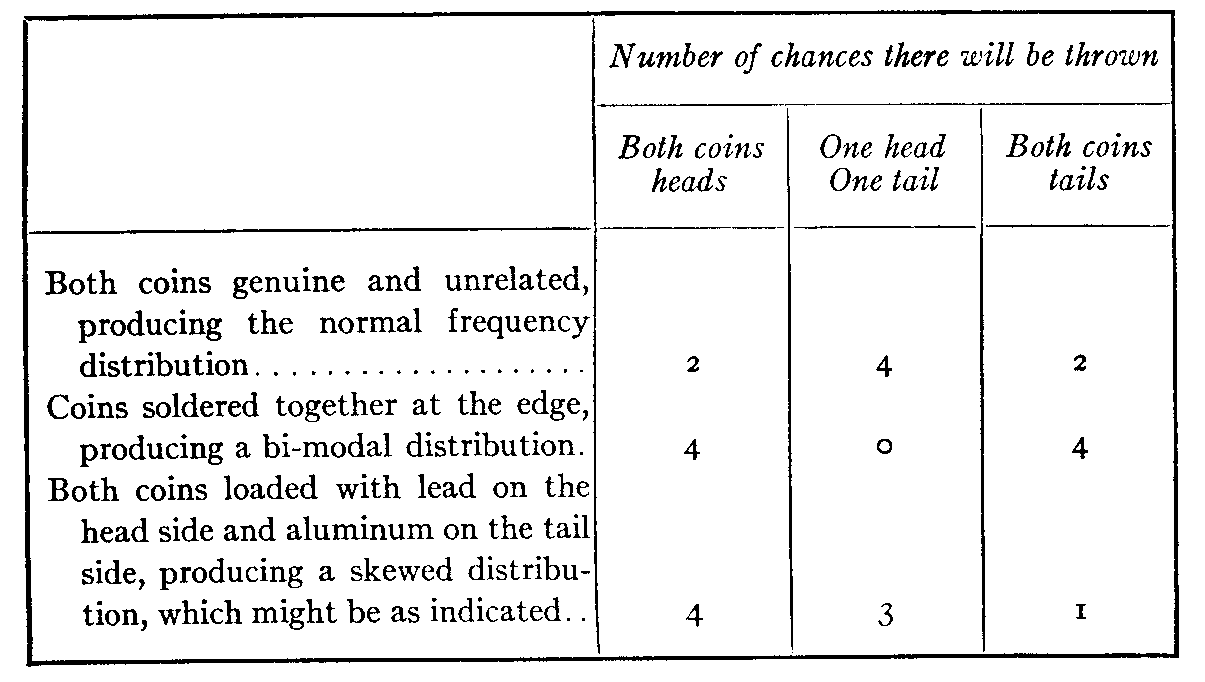
It will be apparent that skewness and departure from a single mode will be indications that the fundamental influences determinative of our measurements are not a set of numerous, equi-potent and independent factors.[3] The question in which we are here interested is to discover the nature of the relationships in these respects among the factors productive of attitudes. There seems to be no obvious a priori reason to suppose that the political attitudes of individuals do not follow the normal frequency distribution which is characteristic of more easily measurable mental characteristics or products. As was pointed out above (p. 53) the factors which are directly or indirectly, consciously or unconsciously, determinative of attitudes seem to be numerous. Moreover, each of us seems to encounter constantly a wide variety of attitudes or expressed opinions on the part of others. Considering the political group as a whole, and
( 75) the opportunities of each individual to be influenced by those of differing opinion with whom he comes in contact, there appears to be a situation similar to that which produces the normal distribution in the case of heights.
We are in fact accustomed to recognize variability of attitude. We distinguish between opinions on either side of a given issue which are lightly or strongly held, between those which are predominantly emotional and those which are predominantly intellectual in character, between those which are moderate and those which are extreme. However, we neglect to note the intermediate positions along these various scales of opinion, because it is difficult to do so.[4] Moreover, the democratic concept, in which, according to Bryce,[5] the idea of "one man one vote" is central, hastened to direct attention away from qualitative differences between individual opinions.
It is conceivable that with the development of the technique of mental measurements, qualitative differences in individual opinions might be valued in the process of measuring the collective decision on a given political issue. With respect to the collective decision on prohibition, for example, we might assign greater value to the opinion which was based on scientific analysis of the physiological, social or economic effects of the liquor traffic than to the opinion which represented prejudice, self-interest or casual impression. We might even be willing to weight the opinion which represented strong conviction, relative to the opinion which was weakly held and very near the point of indifference. According to any one of the possible lines of classification, an average opinion might theoretically be obtained, in which
( 76) each opinion was weighted according to its place along the scale in the entire distribution.[6]
While the fact of variability in political attitudes is recognized and even has certain utilizations in systems of plural voting, little effort has been made to discover the form of distribution. Arguing from analogy, it would be logical to set up the hypothesis that the attitudes upon a given question of individuals in a given group are distributed normally. It would have to be assumed that this question was one which did not affect all members of the group alike in opposition to some other group; further, that the group was sufficiently homogeneous to provide all members thereof with some interest or concern in the outcome. For example, the hypothesis would not cover the distribution of attitudes among German-Americans on the question of declaring war upon Germany; nor would it cover the attitudes of New York voters upon the detailed controversies concerning the Colorado River improvement. It would cover the question of American relations with Germany within the American electorate as a whole (in which case German-Americans might be expected to comprise the more atypical individuals at one end of the distribution) and it would cover the larger aspects of flood control in the Mississippi valley, in which the entire nation, presumably, has a humanistic interest and a material stake.
Such an hypothesis was set up by the present writer a few years ago, but without experimental verification.[7] Its fate
( 77) affords an interesting illustration of the value and the dangers of analogical and deductive reasoning in social science. It was contended that the vote provides a crude measurement of attitudes or opinions which are complex and variable. With this device, opinions which would normally be distributed continuously are consolidated into a discrete series, containing but two classes. That is, opinions which would normally fall at all values along the X ordinate are grouped into two classes of pro and con. Instead of smoothing the histogram into a curve, the reverse process occurs; out of the curve is constructed a histogram of two classes containing all of the frequencies in the series.
The class limits, as in the case of every other series, are fixed arbitrarily; but since there are but two classes, each extends in one direction to the extreme value included in its side of the distribution. Hence there is but one class limit to be arbitrarily defined — the point at which the issue shall be drawn for presentation to the voters. According to the location of this limit on one side or the other of the mode of opinion, the verdict of the electorate will be "for" or "against." Statesmen and politicians are successful according to their ability to estimate this modal opinion and define the issues accordingly. It follows that no genuine issue is likely to remain drawn at a point which is far removed from the central massing of opinion. Extremists, sensing the futility of getting their views adopted, or even voted upon, decry political methods and call for "direct action" to secure their ends.
This hypothesis was illustrated and to a certain extent tested by its application to some leading political issues before the American people, among these the tariff. It is possible to distinguish five positions in order along a scale which would represent differing views upon this question.
( 78)
These views would be (I) absolute free trade; (2) tariff for revenue only; (3) low protection; (4) high protection; (5) complete isolation, or embargo on imports. These views may be represented graphically and in wholly hypothetical form in Figure I. That each position is relative and shades
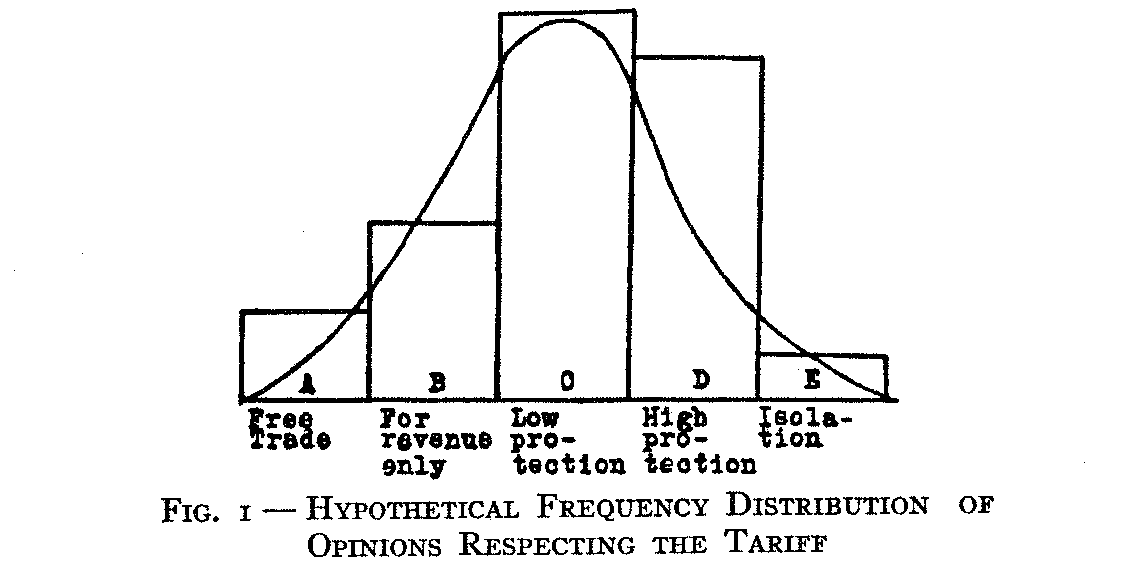
imperceptibly into the position adjoining, will be apparent if we consider the differences between high protectionists and low protectionists.
Let us assume a legislative body, each member of which is in favor of a tariff, but uninfluenced in his vote by party considerations or factors other than his own attitudes. Assume further that this legislature is confronted with the task of fixing the duty upon a specified commodity. Suppose that proposals for an ad-valorem duty are brought before this body, each proposal in turn representing an increase of five per cent in the tariff contemplated. We should expect with each proposal to find a number of legislators who would desert the high tariff side of the division and go over to the low tariff side. Thus the number of high protectionists and low protectionists, so far as the tariff is judged upon its merits alone, depends entirely on the point at which the issue is drawn for decision.
( 79)
In the American Congress the tariff issue has usually been drawn within the ranges of attitude which we have characterized as "low protection" and "high protection." The Republican and Democratic parties, as represented in Congress, have stood for "higher" and "lower" tariffs, respectively. It is obvious that American attitudes, as distributed between free trade on one extreme and national economic isolation on the other, tend to mass within a range calling for some kind of tariff protection for American industries. Too great a departure from this central mass of opinion in either direction by the party in power will throw the mode of the distribution into the class represented by the opposition party, and create a party turnover at the next election. [8]
In Figure 2 the frequency distribution of attitudes or opinions respecting the tariff which was postulated graphically in Figure 1 has been broken up into a series of bi-segmented histograms to represent the probable result of a vote, if the issue were drawn in turn between each two consecutive positions of the five that were distinguished. Thus if the vote were upon the question of free trade (histogram 2) it would be expected that the persons whose attitudes were represented by A (in Figure 1) would vote in the affirmative, and those represented by B, C, D, and E in the negative. If the vote were upon the question of low protection vs. high protection (Histogram 4) we should expect A, B, and C to unite in the affirmative against D and E.
( 80)
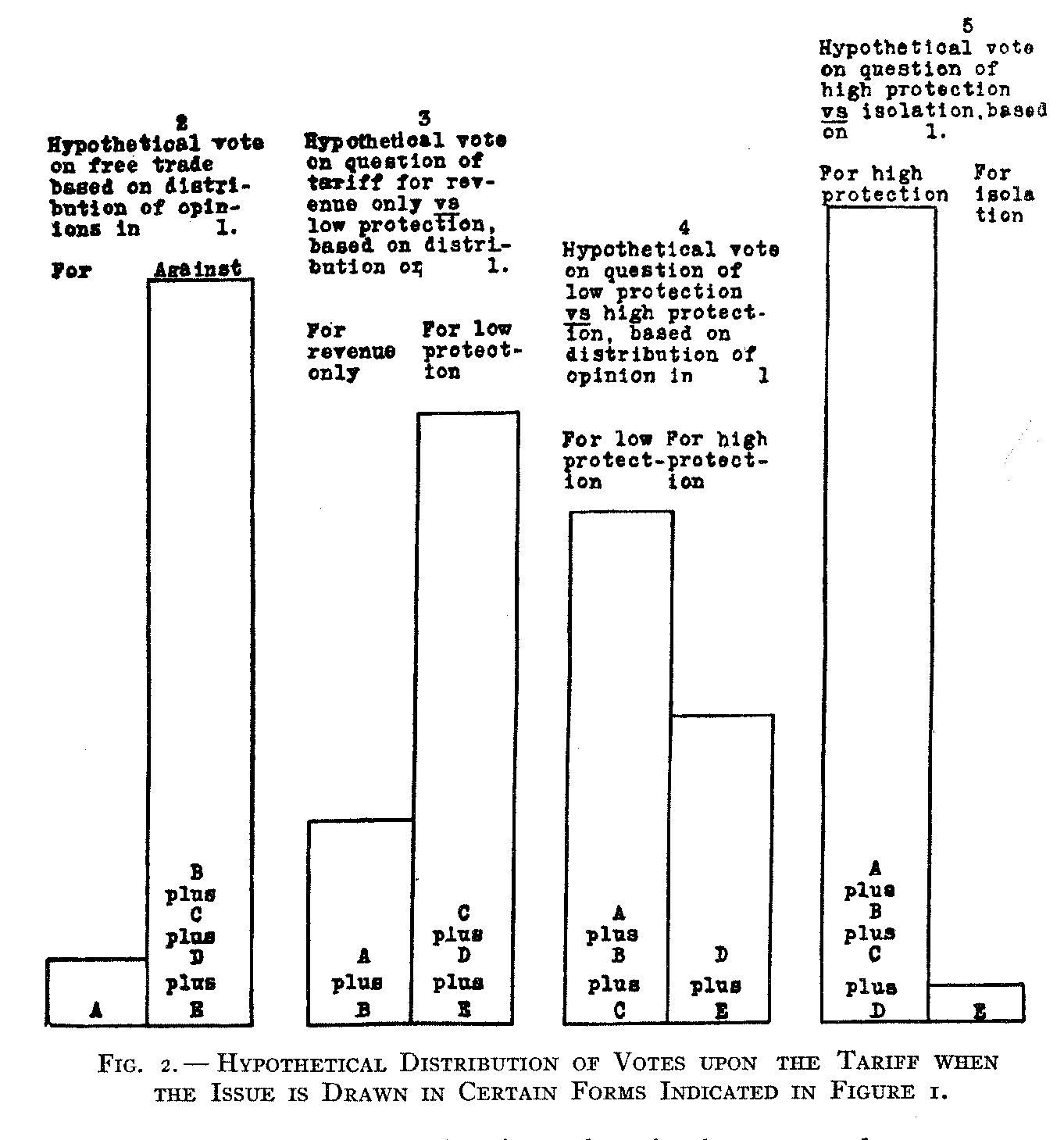
The continuous distribution of attitude on another question was indicated by a poll on prohibition taken by The Literary Digest.[9] The histogram in this case contained three classes rather than the conventional two presented by an "aye" and "nay" vote. The voter could be recorded either
( 81)
(I) for continuance and strict enforcement of the Eighteenth Amendment and the Volstead Act; (2) for modification of the Volstead Act to permit light wines and beers; (3) for repeal of the Prohibition Amendment. The fact that no one of these classes was represented by a majority of the votes led to claims by the propagandists on both sides that the results represented a victory for their own extreme point of view. "Drys" called attention to the majority against a return to "wet" days. "Wets" called attention to the majority against the existing stringent enforcement laws. Each drew the issue at a different point along the scale.
As still a third distribution of attitude there were cited the various positions taken upon the question of public owner-ship. At one extreme the anarchist holds for complete individualism, at the other the extreme socialist would place all industry under state control. In the middle ranges are to be found those who would nationalize the railways; those who would add coal mines to railways; those who would add to these the packing plants and the flour mills. Individual and class interests help to determine the particular industries or services which the individual would be willing to have publicly owned. Hence as to any particular industry, attitude might be multi-modal or skewed. Still it was thought probable that the thoroughgoingness of public-ownership opinion in the abstract would remain normal in distribution.
The general hypothesis just described, together with some further corollaries which will be cited later, was advanced by the writer at about the same time that substantially the same notions were independently suggested by Professor Floyd H. Allport in collaboration with Mr. Dale Hartman. There was, however, this difference: Allport and Hartman
( 82) proceeded to test their ideas by actual inductive experiment, whereas in my own case the hypothesis in its general form was not tested, and was supported only by logical analysis of deductive character. As will presently appear, the experimental procedure tended to substantiate the belief that attitudes can be thought of as distributed along a scale; but it tended also to discredit the hypothesis that they are distributed normally.[10]
The technical procedure that they adopted is worthy of careful attention by the students who are now experimenting along similar lines. Upon various phases of seven concrete issues of current political interest, sixty upperclassmen at Syracuse University were asked to write their personal views. "The resulting opinions on each issue were then carefully sifted and the distinct and relevant views were assembled. Keeping the issues separate, these views were printed on slips of paper and arranged independently by six judges, teachers of political science and psychologists, in order of their logical position in a scale ranging from one extreme on the issue in question to the opposite extreme. The average rank assigned to each statement was taken as its final rank in the completed scale." Students (freshmen in the college of liberal arts) were instructed to check the one statement regarding each of the seven issues which most nearly coincided with his or her view. "With each issue
( 83) there was provided a place for the student to check the certainty of his opinion on a graphic scale of five steps ranging from `extremely uncertain' to ` extremely certain.' A similar scale was provided for checking the degree of intensity of interest or feeling upon the question concerned." [11]
An average of 367 opinions upon each issue were obtained in this manner. Their distribution is shown in Figures 3 to 9
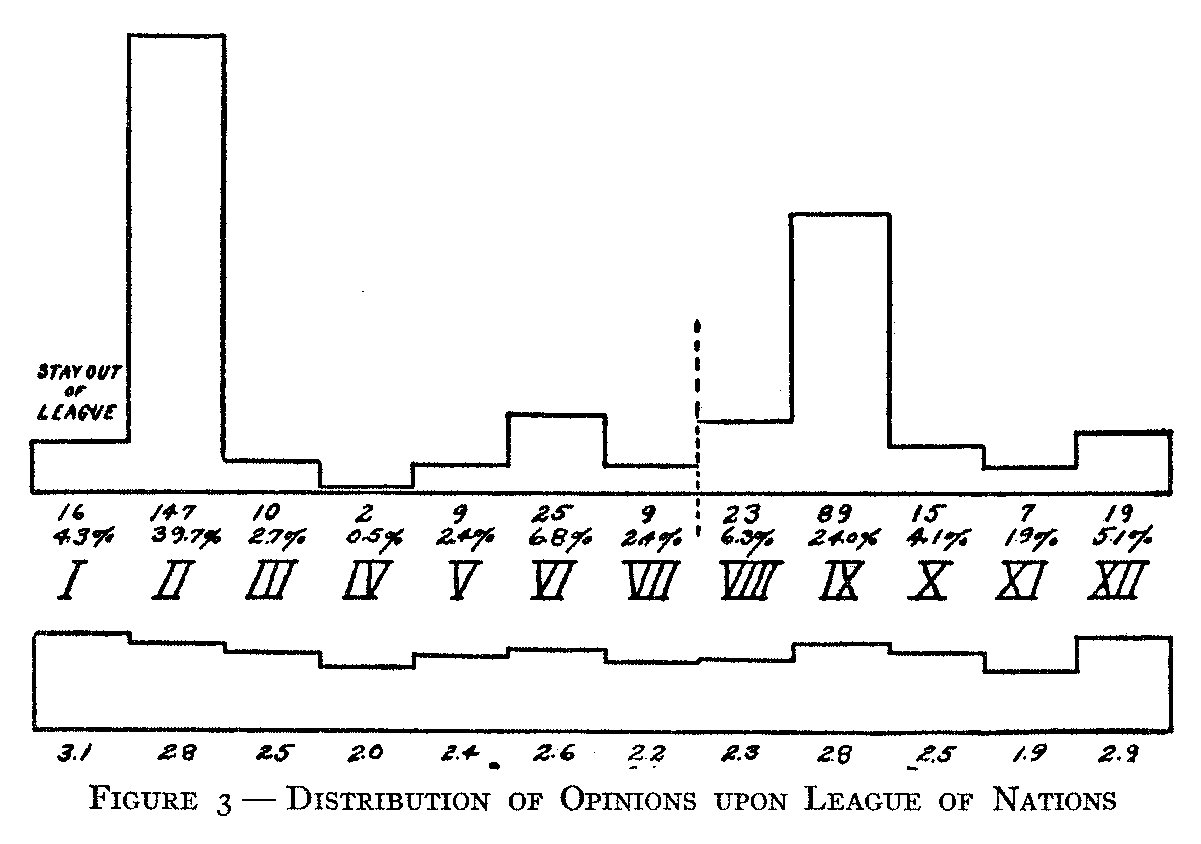
inclusive, which are reproduced here from the Allport-Hartman study. It will be seen from these charts that all of the three forms of distribution mentioned above on page 73, i.e., approximately normal, multi-modal, and highly skewed, are present. Thus attitudes toward the League of Nations (Figure 3) were decidedly bi-modal, a division occurring
( 84) "possibly upon party lines." Twelve positions on the attitude scale were distinguished upon this issue, ranging from the extreme policy of isolation at position I to the opposite extreme, calling for a world-state, at position XII. Position II, calling for non-adherence to the League but for friendly coöperation with other nations, represented the opinions of 147 students or 39.7 per cent of the number; but position IX, calling for adherence with subsequent adjustment of
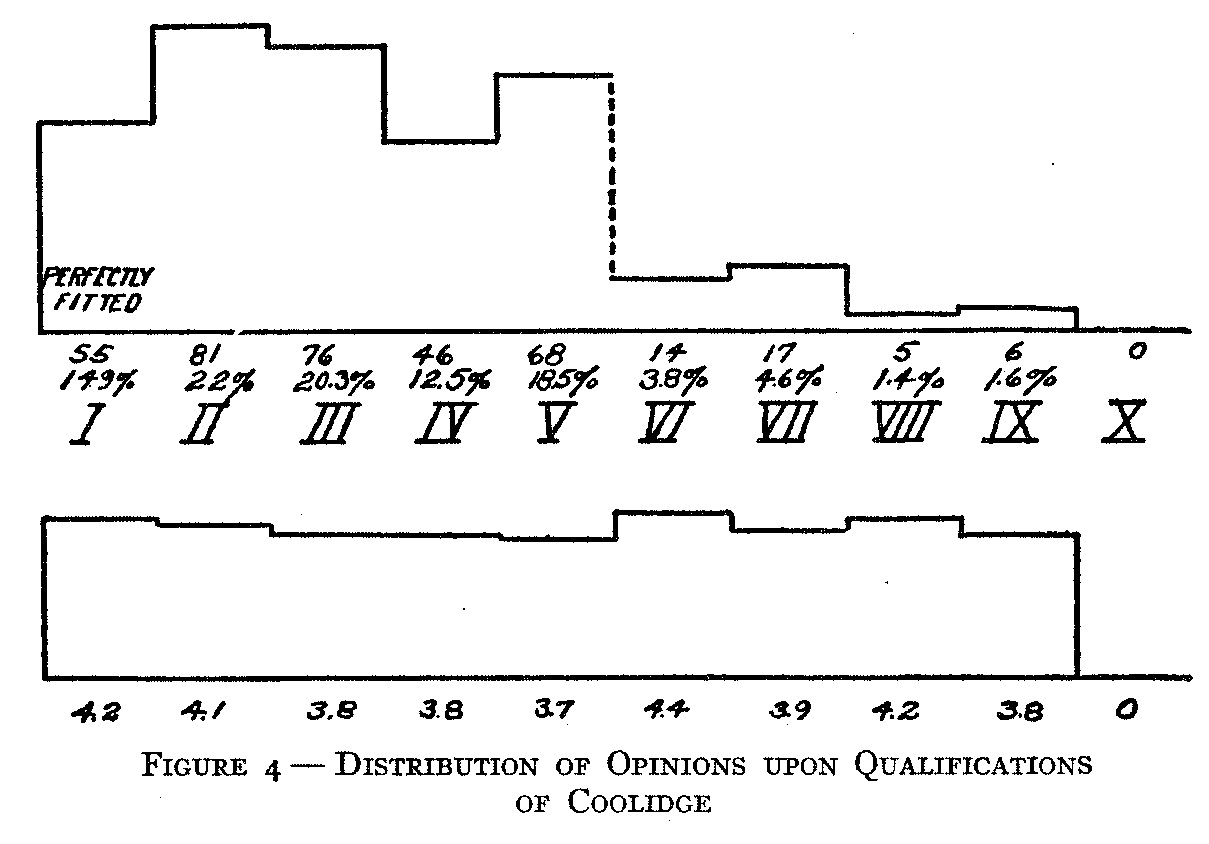
defects, expressed the opinions of 89 students and represented a second modal point upon the scale.
Two or possibly three modal points are similarly found among proposals, eleven in number, respecting Congressional control over Supreme Court decisions upon matters of constitutionality. (Figure 5.) With respect to the qualifications of Coolidge for President (Figure 4) the distribution of attitudes appears to have a single well-defined mode, but the preponderance of opinions was favorable and the distribution
( 85) was skewed. In the case of the Ku Klux Klan (Figure 9) at least three modes seemed to appear. On the distribution of wealth and the question of graft in politics (Figures 7 and 8) a tendency toward normal distribution of attitude was apparent, although both were skewed. The prohibition question (Figure 6) develops what is perhaps the most curious distribution of attitudes of all, for while the sentiment for prohibition is overwhelming, the small pro-licence minority
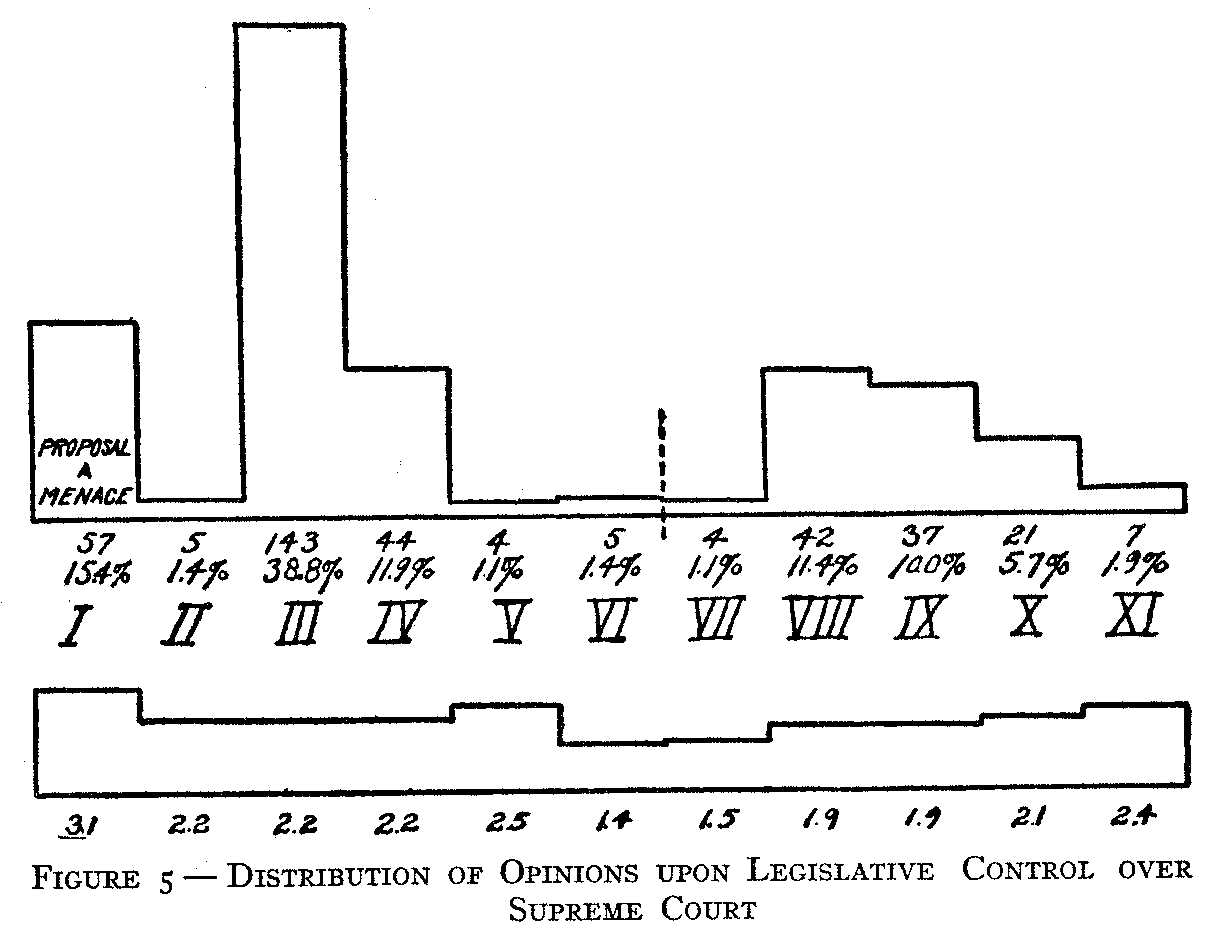
arrange themselves in "a little distribution curve of their own" which at most points is "practically normal."
On the whole, then, the hypothesis that political attitudes tend to be distributed normally has fared rather badly in the light of experimental verification. It must be recalled that the subjects were freshman students in a university — a group much more homogeneous in most respects than a ran-
( 86) -dom sample of the electorate. Since heterogeneity and variability mean substantially the same thing, the electorate would undoubtedly be even more diverse in its distributions of attitude than were these students.
In another particular, however, my hypothesis survived the Allport-Hartman experiment. As a corollary I made this suggestion : "If political opinions are distributed in the normal manner, it is probable that radical changes in public
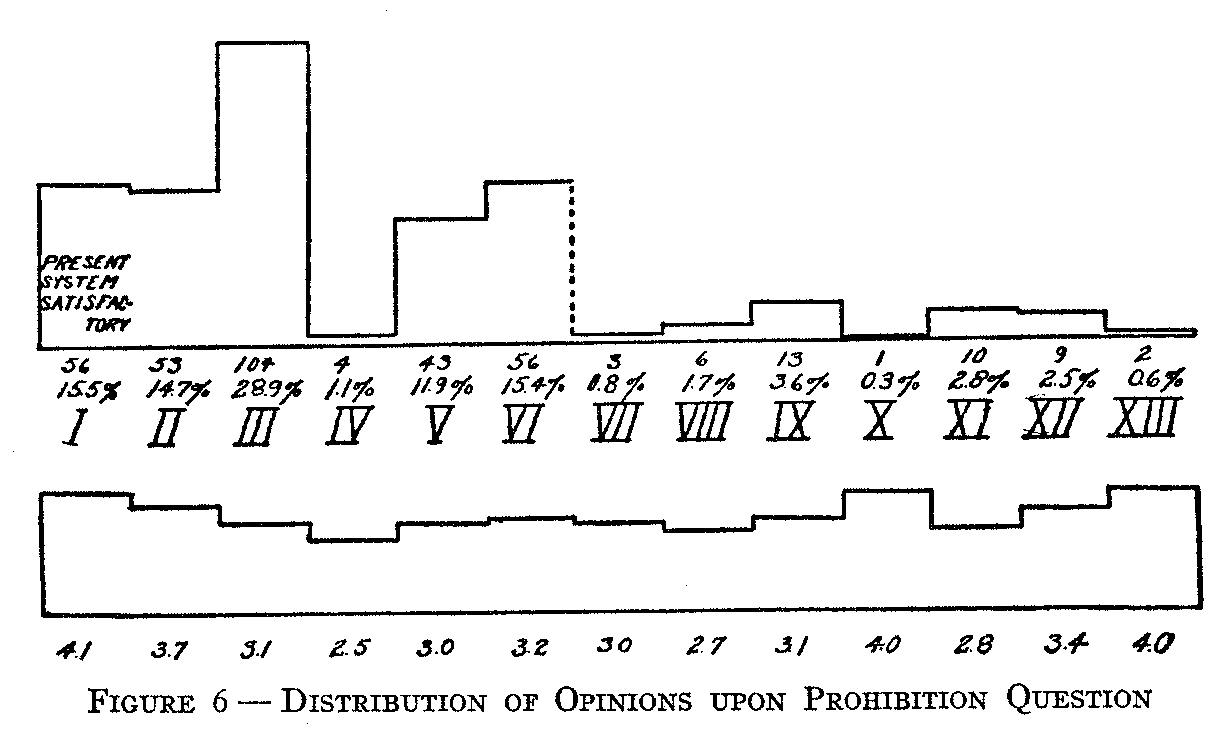
opinion occur less frequently than is usually supposed. The relative strength of parties at election time may be changed in either of two ways. In the first, the points at which the issues are drawn may remain constant. Hence, a comparatively slight shift of the modal opinion may bring about a transfer of power from one party to another that appears superficially as a `sweeping verdict at the polls.' Nevertheless, the shift is most likely to have taken place within the central quartiles of the distribution where opinion most nearly approaches indifference. Subsequent events usually prove in such a case that the changes of opinion were not may be shifted. When this occurs, it is usually the result of maneuvering for advantage on the part of
( 87) politicians and party leaders. Old issues are presented in a new light, so that in effect the opinions of the electorate are reclassified and new class limits are established. Any shift of party strength between two elections in which the same issues are presented probably involves both of these occurrences."
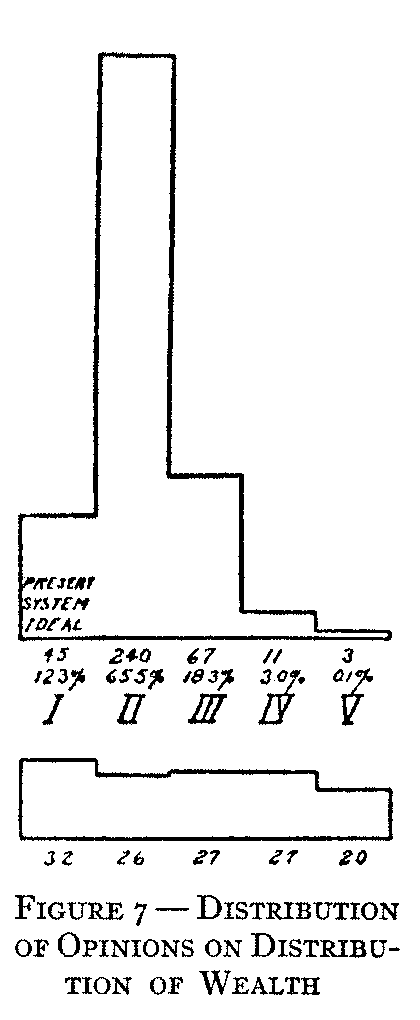 By a somewhat different line of reasoning, Allport and Hartman arrived at a
similar hypothesis: "It is suggested that the atypical extremists are actuated
in their thinking by partially repressed emotional drives, and that they develop
a method for concealing from themselves and others the fact that their opinion
is profound or thoroughgoing. Opinions lightly held are easily changed. Thus the
fickleness of public opinion that is so frequently observed may be a phenomenon
representing the comparative indifference of the central portions of the
distribution of opinion.
By a somewhat different line of reasoning, Allport and Hartman arrived at a
similar hypothesis: "It is suggested that the atypical extremists are actuated
in their thinking by partially repressed emotional drives, and that they develop
a method for concealing from themselves and others the fact that their opinion
is profound or thoroughgoing. Opinions lightly held are easily changed. Thus the
fickleness of public opinion that is so frequently observed may be a phenomenon
representing the comparative indifference of the central portions of the
distribution of opinion.
" In the second case, opinions may remain distributed in the same way, but the points at which the issues are drawn determined rather by wishes than by the process of reason.[12] Dogmatic certainty and moral conviction are the means adopted to offset, of course unconsciously, the challenge that so extreme a view as theirs should be carefully analyzed. To put it another way, if one wishes to hold a certain belief
( 88) which happens to be of an extreme sort, one must have a strong conviction. Otherwise, one can not feel justified in holding the view in the face of the great majority who think differently. On a priori grounds we should expect, therefore, that those who stand at the atypical extremes would express the greatest degree of certainty in their opinions."
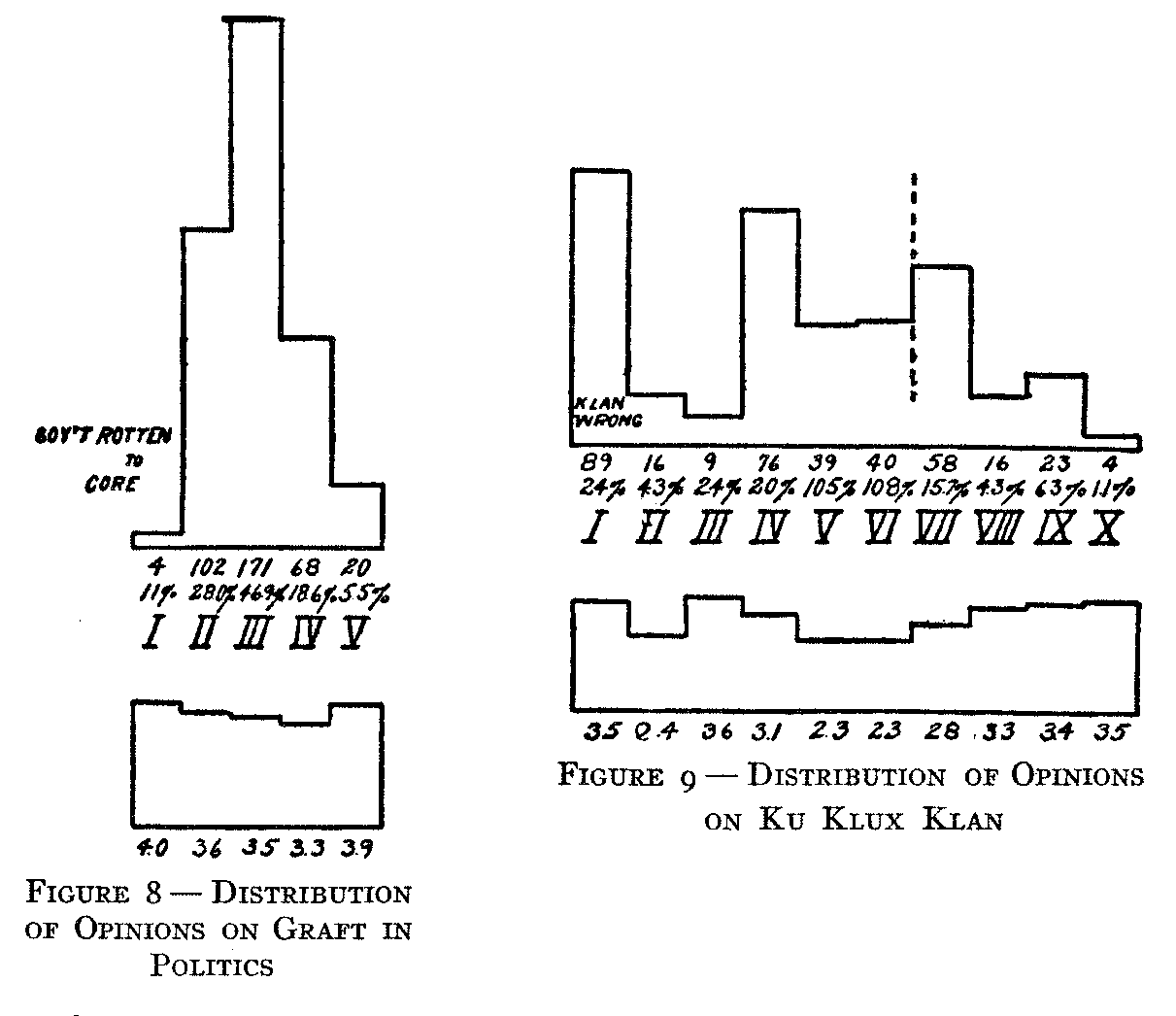
Let us again look at the actual evidence which the authors found. Below each curve of distribution in Figures 3 to 9, they have plotted in a flat-shaped graph, beneath each step in the scale, the average certainty which was felt by the persons who chose the view represented by the step in question. "The possible range of certainty scores is from i to 5; and the units of vertical distance express the position of the average point of certainty upon this scale." Thus,
( 89) with regard to the League of Nations (Figure 3) the two extremes, positions I and XII, "show the highest certainty of opinion, the averages being 3.1 and 2.9 respectively. At the reactionary end we also find three successive certainty steps upward in direction opposite to the decreasing extremeness of views I, II, and III."
Without going into the details of each distribution, it may be said that the authors found evidence in the case of each of the seven issues that persons taking the more atypical positions on the attitude scale held their opinions with a higher degree of certainty than those whose opinions fell near the modal points. Moreover, the ratings for intensity of feeling were correlated closely (coefficient above 0.90) with the ratings for certainty. "Intensity and certainty go together."
To the extent, then, that attitudes were shown to be normally distributed, support was given to my contention that the fickleness of public opinion might be "a phenomenon representing the comparative indifference of the central portions of the distribution of opinion." The manner in which a subsequent study of my own has run counter to this aspect of the hypothesis is shown in Chapter XIX.
On the whole, I am still inclined to believe that there is "something in" the hypothesis that individual attitudes are distributed normally, apart from some distorting situation. Scientists customarily reason in this manner. Thus the law of gravitation states what would happen under certain ideal conditions which are never exactly attained in actuality. But there is little more than futility in employing an hypothesis based upon ideal conditions unless the latter are some-times approximated in actuality. Such procedure in economic theory was largely responsible for giving it the "dismal" reputation that it once possessed.
If normality of distribution should be established as an
( 90) ideal situation frequently approximated there would be practical and theoretical implications. To cite one of the former, it could be shown that movements for political reform are more likely to succeed when proceeding step by step, than when presenting their complete program. The mode may be shifted, but slowly. If the political change which is made as a result of the first distribution of attitude proves satisfactory to the voters, the modal shift is likely to continue in the same direction, and successive steps may prove possible.
For example, a distribution of attitude three decades ago with regard to the political rights of women would probably have disclosed the following points along the scale: (1) Women should have no voice in public matters; (2) women should have a voice in voluntaristic organizations, as in church societies, but in no other; (3) women should have the suffrage with respect to school elections; (4) school and municipal suffrage should be given; (5) all suffrage except for national elections should be allowed; (6) complete national suffrage as well as local; (7) women should unite in politics, attempting to secure sex dominance in public matters. With many minor variations, the issue of woman's rights has been drawn in turn between each consecutive pair of these various positions on the scale. The mode of individual attitudes has been shifted constantly in the same direction until it is now to be found, quite clearly, within the group of attitudes which sanction all forms of voting equality between men and women. It has not yet shifted to the point at which office-holding for women is regarded with equal favor, nor to the point at which woman's dominance in politics can be regarded as a practical possibility.
Further research upon the distribution of individual attitudes might disclose under what circumstances it may be
( 91) "normal." If the distribution is not normal, it is because the factors determining individual attitudes are not numerous, equi-potent and independent. Here, even if the results were wholly negative from the standpoint of establishing normality of distribution as a typical or approximated ideal situation, it might still be possible to discover the circumstances which produce non-normal distributions. It is not impossible that this would be of even greater value, for it might disclose information concerning the modes of association and interaction among the factors which are creative of our individual attitudes and states of mind.[13]